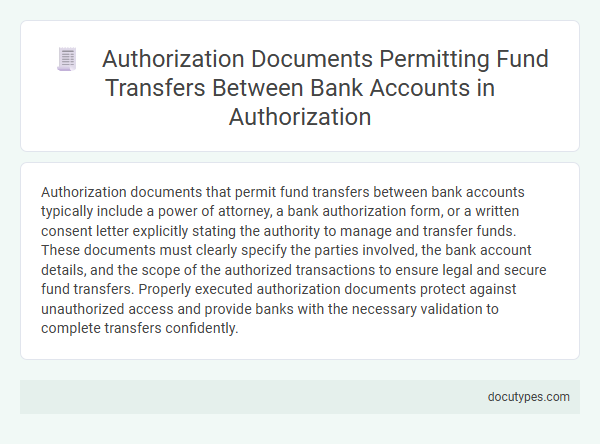Authorization documents that permit fund transfers between bank accounts typically include a power of attorney, a bank authorization form, or a written consent letter explicitly stating the authority to manage and transfer funds. These documents must clearly specify the parties involved, the bank account details, and the scope of the authorized transactions to ensure legal and secure fund transfers. Properly executed authorization documents protect against unauthorized access and provide banks with the necessary validation to complete transfers confidently.
Introduction to Authorization Documents for Fund Transfers
Authorization documents are essential for enabling fund transfers between bank accounts. These documents grant permission to initiate and approve transactions securely.
You need specific forms such as a Power of Attorney or a Fund Transfer Authorization Agreement. These documents ensure that the transaction complies with banking regulations and protects your financial interests.
Importance of Authorization in Inter-Bank Transactions
Authorization documents are crucial for enabling secure and compliant fund transfers between bank accounts. They ensure that transactions are verified, reducing the risk of fraud and errors in inter-bank activities.
- Power of Attorney - Grants a designated individual the legal authority to execute fund transfers on behalf of the account holder.
- Bank Mandate - Specifies authorized signatories and conditions under which transfers can be processed between accounts.
- Transaction Authorization Form - Provides explicit consent from the account owner for each specific transfer, ensuring traceability and accountability.
Key Components of Fund Transfer Authorization Letters
Authorization documents enabling fund transfers between bank accounts primarily include Fund Transfer Authorization Letters. These letters must clearly specify the account holder's identity, the beneficiary's bank details, the transfer amount, and the purpose of the transaction. Including a valid signature, date, and any relevant identification numbers ensures the document complies with banking regulations and facilitates smooth processing.
Legal Requirements for Authorization Documents
Authorization documents that allow fund transfers between bank accounts must comply with strict legal requirements to ensure validity and security. These documents typically include signed mandates or power of attorney forms that explicitly grant permission for transactions. Compliance with banking regulations and verification of identity within these documents is essential to prevent fraud and unauthorized transfers.
Types of Authorization Documents for Bank Transfers
| Type of Authorization Document | Description | Purpose in Fund Transfers |
|---|---|---|
| Power of Attorney (POA) | A legal document granting one person the authority to act on behalf of another in financial matters. | Allows authorized individuals to initiate and approve fund transfers between bank accounts. |
| Bank Authorization Letter | A written and signed instruction from the account holder authorizing the bank to perform specified transactions. | Used to permit fund transfers, including scheduled or recurring payments, between accounts. |
| Third-Party Authorization Form | A form provided by banks allowing account holders to authorize third parties to access and transfer funds. | Enables transfers by authorized third parties within predefined limits set by the account owner. |
| Digital Authorization via Online Banking | Secure digital approvals using credentials like passwords, OTPs, biometric verification, or digital signatures. | Allows You to electronically authorize immediate fund transfers between linked bank accounts. |
| Corporate Resolution or Board Authorization | Official documents passed by a company's board or management authorizing specific individuals to handle company bank accounts. | Permits authorized company representatives to perform fund transfers on behalf of the organization. |
Step-by-Step Process to Draft an Authorization for Fund Transfer
Authorization documents are essential for legally permitting fund transfers between bank accounts. Drafting a clear and precise authorization ensures compliance and prevents unauthorized transactions.
- Identify Involved Parties - Clearly specify the names and account details of both the sender and receiver to avoid ambiguity.
- Define Transfer Limits - State the maximum transfer amount and the duration for which the authorization is valid to control transaction scope.
- Include Signatures and Dates - Ensure the document is signed and dated by authorized individuals to validate consent and accountability.
Following these steps creates a comprehensive authorization document that facilitates secure and efficient fund transfers between bank accounts.
Security Measures in Authorization Documents
Which authorization documents allow fund transfers between bank accounts? Authorization documents such as bank mandates, power of attorney, and signed transfer instructions enable fund transfers by verifying the account holder's consent. These documents implement security measures like signature verification, access control, and multi-factor authentication to prevent unauthorized transactions.
Common Mistakes in Fund Transfer Authorizations
Authorization documents enabling fund transfers between bank accounts typically include signed agreements and specific transfer requests. Common mistakes in these authorizations can lead to processing delays or denied transactions.
- Incomplete Signatures - Missing or unclear signatures invalidate authorization documents and halt fund transfers.
- Incorrect Account Details - Providing wrong account numbers or bank information causes failed or misdirected transfers.
- Lack of Proper Authorization - Failure to obtain explicit consent from authorized parties results in compliance issues and potential disputes.
Sample Templates for Authorization Letters
Authorization documents for fund transfers between bank accounts include formal letters granting permission to move funds. These letters must specify the account details, authorized signatories, and the scope of the transfer rights.
Sample templates for authorization letters typically feature clear identification of the authorizing party and recipient bank. They also outline the transfer limits, effective dates, and necessary signatures to validate the document.
Which Authorization Documents Allow Fund Transfers Between Bank Accounts? Infographic

